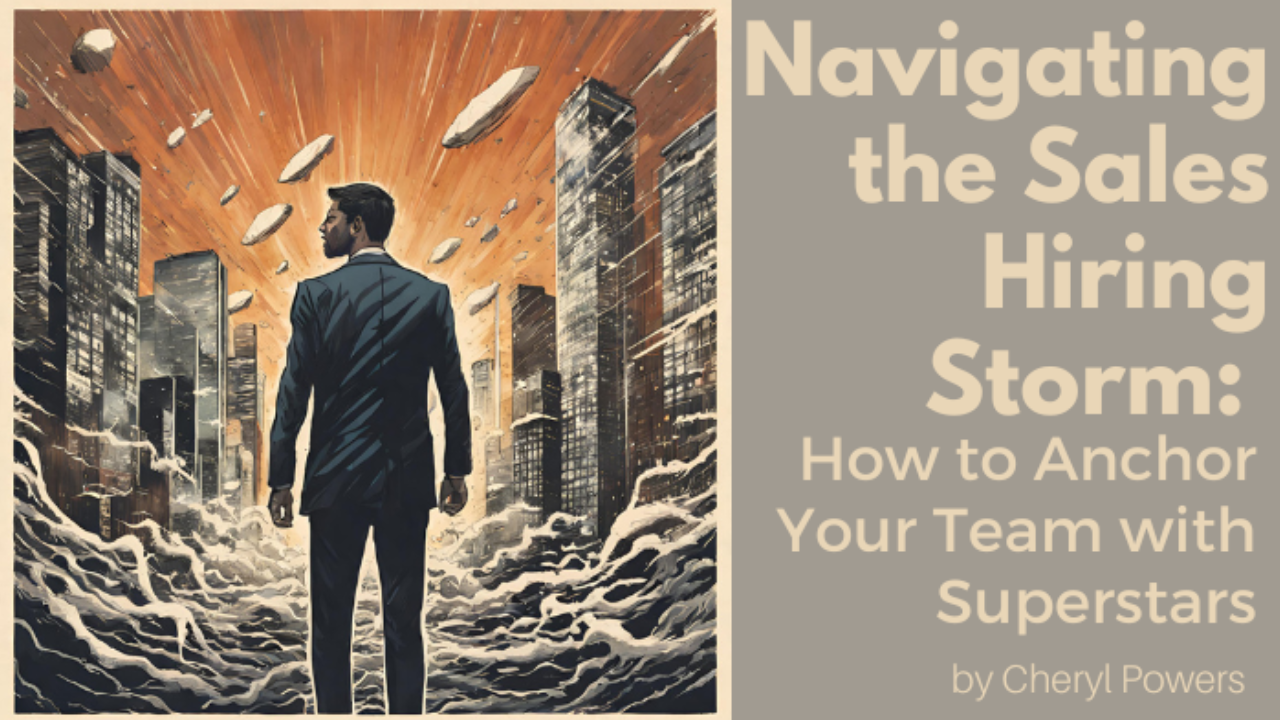Navigating the Sales Hiring Storm: How to Anchor Your Team with Superstars

By Cheryl Powers
Imagine for a moment the enterprise value your company could reach if every sales hire turned out to be a veritable superstar, a perfect fit for the demanding rhythm of your business. Now imagine what that would mean to you personally.
What would it add to your customer happiness?
What would it do for your employee satisfaction?
How would it impact your standing against the competition?
And what would it do for your personal wealth?

Yet, here's the sobering reality: nearly 80% of employee turnover stems from initial hiring mistakes, especially in sales—a sphere where the wrong choice can cost upwards of $700,000 per mis-hire when you tally up squandered leads and vanished customers.
As the captain of your ship, whether you consistently hit your sales targets or flounder in the choppy waters of missed opportunities hinges on the caliber of salespeople you bring aboard.
Let's face the music: most of your managers are navigating the hiring process with a broken compass.

The Corporate Executive Board's stark revelation that managers consider one in five hires to be a blunder should be a wake-up call.
DePaul University echoes this with a finding that a third of new sales recruits abandon ship before their first anniversary.
What's causing this hiring headache? It's a blend of missteps and missed opportunities.
Now, let's chart a course to calmer waters with a map to masterful sales hiring:
Understanding the Sales Role
A sales role is not a one-size-fits-all hat. Identify what you truly need—whether it's a farmer to cultivate existing relationships or a hunter to spearhead new conquests. Craft your role specification to uncover these distinct traits.
As you approach the hiring process, you must recognize that each sales role is nuanced, much like a tailor-made suit rather than a generic garment off the rack. It's imperative to discern the particular type of professional your team requires and then drill down to what that means for your particular sales role.
Do you need a farmer—someone who tends the crops, nurtures the soil of existing relationships, and ensures a steady harvest? Or are you searching for a hunter, an individual who thrives on the thrill of the chase, equipped to navigate the wilds of the market to bring in the bounty of new and ideal customer orders?
This isn’t simply a job description detail; it's the cornerstone of your hiring strategy.
Your role specification must be a finely tuned instrument, designed to resonate with these distinct salesperson requirements, skills, talents, aptitudes, behaviors, etc. It's about crafting a blueprint of your ideal candidate.
By recognizing this critical distinction, you can steer your hiring process in a direction that aligns with your business’s growth strategy and cultural ethos.

Searching in the Right Places
Great salespeople aren't usually found unmoored on job boards; they're gainfully employed - - out there making waves. Shift your recruitment tactics to actively seek these high achievers who aren't necessarily on the market but are in the market for greatness.
The search for exceptional sales talent requires a proactive and strategic approach, like a well-planned marketing campaign aimed at a select audience rather than a broad, indiscriminate advertisement.
The top sales talent, those with a proven track record of exceeding targets and forging strong customer relationships, are often not actively looking for job opportunities; they are deeply engaged in their current roles, driving success for their employers.
To tap into this pool of high achievers, you must look beyond the traditional recruitment avenues. Top performers are likely to be recognized within their industries, speaking at conferences, contributing to thought leadership, or maybe quietly celebrated within their current companies.
They could be individuals who are satisfied but would consider a change if an opportunity aligns with their professional growth goals and personal values.
Crafting a recruitment strategy to attract these passive candidates involves leveraging industry networks, engaging with professional associations, and using targeted headhunting tactics.
Your sales leaders and recruiters must act as talent scouts, attending industry events not just to sell products, but to observe and interact with potential candidates. They must cultivate a keen eye for talent, recognizing the subtle indicators of a strong salesperson, like how they network, their reputation among peers, and their visible passion for the profession of sales.
Leveraging social media and professional networking platforms in a sophisticated manner is key. It's not about posting a job and waiting for applicants; it's about engaging with potential candidates where they are active, sharing insights, and contributing to conversations that matter to them.
This approach enables your sales leaders to build relationships and gain insights into the character, competencies, and capabilities of the people they’re considering approaching.
Networking within your existing team can also be a goldmine. Your top salespeople likely know others in the industry who are as driven and successful as they are.
Implementing a referral program that incentivizes your team to bring talent to your door can yield excellent results, often bringing in candidates who are a cultural fit and have been pre-vetted by your own trusted employees.
In the realm of sales, where performance is paramount, it is essential that recruitment tactics are as finely tuned and strategic as the sales techniques your best performers use to close deals. This means your recruitment team must exhibit the same level of savvy, data analysis, perseverance, and deep engagement that you would expect from a top sales candidate.
After all, the search for stellar salespeople is, in itself, the ultimate sale, where the product is the career opportunity and the customer is the candidate who will elevate your team to new heights.

The Art of the Interview
Don't let interviews become one-sided sales pitches about your company. And don't let them become salesperson-led soliloquies about what the candidate thinks you should be hiring. Instead, listen intently to discern the candidate's true capabilities and cultural fit.
Interviews are a dance of discovery, and in the context of hiring salespeople, they should be less about broadcasting the merits of your company and more about auditioning a candidate's experiences and potential fit.
When the interview becomes a monologue of your company’s achievements and opportunities, you risk missing the subtle yet critical cues that reveal the true nature and potential of the candidate in front of you.
Step into the role of a casting director. By crafting questions that prompt the candidate to dig deeper, show what they're made of, and share stories and examples from their sales experience, you open a window into their professional capabilities contextualized to the needs of your company.
It's not just about the successes they've had, but also the failures and what they've learned from them. As they articulate their approach to challenges, pay close attention to the details – these often contain the essence of their problem-solving skills, resilience, and creativity.
Active listening requires discipline and mindfulness. It's about hearing the unsaid—recognizing the nuances in tone, the hidden meaning behind words, and the non-verbal communication that accompanies them.
Are they enthusiastic when they speak about certain achievements or strategies?
Do they demonstrate empathy when recounting a customer scenario?
How do they explain their past successes and failures?
Which managers are they most drawn to and why?
These nuances can give you insight into their emotional intelligence and suitability for your team's culture.
Remember, your interview is a two-way street; it's as much about the candidate assessing your company as it is about you assessing them.
Allowing them to ask questions and listening to the types of questions they pose can be very telling. Inquisitive candidates who ask about the company’s values, team dynamics, and long-term vision show a level of engagement and foresight indicative of a thoughtful and strategic salesperson.
To truly master the art of listening, you must also read between the lines. Salespeople are often skilled at presenting themselves; it's a fundamental part of their job.
By listening actively, you can discern whether they're simply selling you an idealized version of themselves or providing genuine insights into their professional capabilities and how they align with your needs.
That’s why it's essential to foster an environment during the interview that encourages openness and authenticity. Set a conversational tone, show genuine interest in their perspectives, and respond thoughtfully to their answers.
This not only yields more honest responses from your candidate but also demonstrates to the candidate the kind of thoughtful leadership and company culture they can expect.
Honing the art of questioning and listening during interviews is crucial for uncovering the true aptitude and attitude of sales candidates. It ensures you don't just hear what you want to hear, but rather what you need to hear to make an informed hiring decision that aligns with the strategic needs and values of your organization.

Patience in the Hiring Process
Resist the temptation to fill a vacancy with a warm body. Hold out for the right fit—even if that means sailing solo for a while longer.
In the quest to find the right salesperson for your team, patience isn't merely a virtue—it's a strategic necessity. The urgency to fill an open sales position can often cloud an owner’s judgment, leading to a rushed decision that may bring aboard a candidate whose fit and abilities are less than ideal. This short-sighted approach can lead to more turnover, increased training costs, and a potential dip in team morale.
Many full-service recruiting clients of ours are surprised when we tell them that we may only bring them a few candidates. But they're relieved to know that the sales and sales management candidates we bring them are fully vetted and guaranteed to rise to the top of their sales team. And our Sales Hiring Accelerator clients are always happy to learn how to get those results themselves.
Take a step back and consider the long-term implications of a hasty hire. A new salesperson is not just filling a seat; they're potentially reshaping the dynamic of your existing team, impacting customer relationships, and influencing your revenue and profit streams for the long term. The ripple effects of a bad hire can be widespread and long-lasting.
Instead, commit to holding out for a candidate who not only has the requisite skills and competencies but also aligns with the core values and culture of your organization. This means sometimes having to navigate the interim period with a gap on your team, but this temporary challenge is often outweighed by the benefits of waiting for the right person. In the interim, lean on the strengths of your current team, perhaps offering temporary incentives for extra efforts to cover the gap.
During this period, keep refining your recruitment strategy. Use this time to gather deeper insights into what skills, behaviors, attitudes, and qualities have made your top performers successful and how you can identify those traits in prospective candidates.
Patience also demonstrates to your current team and to future candidates that you are committed to maintaining a high standard. It sends a message that you value quality and fit over expediency, which can be a powerful statement about your brand's integrity and your dedication to your workforce.
Patience also allows for a more thorough interview process. With time on your side, you can afford to delve deeper into a candidate's experience, motivations, skills, and potential. You can conduct multiple interviews, include team interactions, and even involve the candidate in situational exercises that reveal critical skills and traits.
So while there is often high pressure to quickly fill a sales role, resisting the temptation and exercising patience can be the key to securing not just a new employee, but a valuable, long-term contributor to your company's success.
The right fit is worth the wait, and the benefits of a well-considered hire will invariably outweigh the costs of a temporary vacancy.

The Reference Compass
References, if you can approach them adeptly, can be your lighthouse, illuminating the true performance and potential of a candidate. Navigate this process with care, and don't be swayed by smooth talkers.
During the hiring process, references can act as a crucial navigational tool—a compass that guides you toward the truth behind a candidate's shiny resume and polished interview performance.
Just as a lighthouse warns ships of hidden dangers in coastal waters, a thorough reference check has the potential to reveal critical insights about a candidate's past professional conduct and achievements, insights that might be obscured by a candidate's self-promotion or interview charm.
To effectively utilize references as your guiding light, approach them not as a formality, but as a strategic phase of the hiring process.
Develop a series of open-ended questions that encourage detailed responses. Inquire not only about a candidate's job performance but also about their interpersonal skills, their ability to overcome challenges, and their adaptability to change.
How did they contribute to the team and company culture?
Did they consistently meet their targets?
What was the quality of their work under pressure?
These answers can help paint a more complete and accurate portrait of the candidate.
When possible, reference checks should go beyond verifying facts—they should be used to understand the candidate's potential for growth.
How did they handle learning new skills or adapting to new environments?
Are there instances where they went above and beyond their job description?
Knowing how they evolved in previous roles gives you a window into how they might perform and develop within your organization.
Remember, a successful hire is not just about confirming skills and competencies but ensuring alignment with your company's ethos and future direction. In this way, your reference checks should also explore the candidate's alignment with the values and long-term objectives of your business.
The reference compass, when used with discernment and thoroughness, can steer you away from potential missteps and toward a hire that will truly resonate with the needs and aspirations of your business.

Trusting Data Over Instinct
Beware the siren call of "gut feelings." Implement a structured interview process that relies on data and multiple touchpoints to ensure you're not being lured onto the rocks.
When you're hiring top sales talent, relying solely on instinct can be as treacherous as navigating through a fog without a compass.
Human intuition is invaluable, but it can be fraught with biases and errors in judgment. This is where our sales force analysis and our data-driven screening and hiring process come into play.
They serve as sophisticated instruments, honing in on the qualities that make a salesperson a truly exceptional fit for your organization.
You must have a way to glean empirical insights about the skills, competencies, behaviors, attitudes, and traits of your most successful salespeople.
What skills and competencies do they share?
What drives them to want to succeed in sales?
What behaviors do they exhibit in the sales process?
What is their reaction to winning, losing, encountering resistance?
By examining these patterns, (and many more) you can create a data-backed profile of the ideal candidate for your team.
Incorporate these insights into your screening process.
Develop quantifiable metrics and benchmarks from the data derived from your top performers.
Use these metrics to assess candidates, and create a meaningful shortlist of candidates that meet these verifiable criteria before they even reach the interview stage.
Evaluate candidates using a standardized scorecard that aligns with the sales force analysis. This ensures you're measuring each candidate against the same yardstick, minimizing subjective bias and increasing your ability to make an ideal hire that sells more and stays with your company for a longer time.
By placing your trust in a rigorous, data-driven approach that utilizes both a sales force analysis and structured screening, you safeguard your hiring process against the deceptive allure of gut instincts.
You’re not dismissing the human element, you're enhancing it with solid data, ensuring that each new hire is not just a good interviewee but a truly great addition to your sales force.

Onboarding: The Maiden Voyage
Remember, a smooth sea never made a skilled sailor. Onboarding should be like a well-charted voyage—thorough and thoughtfully planned to set the course for success.
Onboarding a new sales team member is like setting sail on a maiden voyage. It's a critical time that determines how well-prepared the individual will be to face the open waters of their new role. An effective onboarding process, like a well-navigated journey, must be thorough, meticulously planned, and tailored to guide the new hire to their destination: becoming a high-achieving, productive, and fully integrated member of your team.
Start with a comprehensive orientation that not only covers the administrative basics but also immerses the new hire in the company culture and values. Just as a sailor must understand the principles of the sea, a salesperson must grasp the foundational elements of the organization they represent.
The onboarding journey should include clear learning objectives and checkpoints.
Like navigational waypoints, these help ensure that the new recruit is on the right path and allow for adjustments to be made if they veer off course.
Introduce them to your sales methodologies, tools, CRM systems, frameworks, and ICP early on, ensuring they have a solid grasp of the technology, tactics, and strategies they'll be using daily.
Provide a mentor or a buddy, someone who knows the ropes and can act as a guiding star. This should be an experienced and successful team member who can offer support, answer questions, and provide feedback in real-time. The mentor can help bridge the gap between theoretical training and practical, on-the-job learning.
Training should also be an interactive and continuous process, not just a single event.
Incorporate role-playing exercises that simulate challenging sales scenarios they'll encounter, allowing them to learn through practice. This is where they can make mistakes in a controlled environment, learn from them, and build confidence.
Just as a ship’s crew must be proficient with their navigational charts, your new sales hire should be equipped with detailed knowledge of the product or service portfolio. Make sure they understand not just the features and the benefits but the problems these products solve for your customers.
Remember that feedback is the compass that helps the sailor correct their course.
Establish a feedback loop where new team members can share their onboarding experiences and suggest improvements.
This feedback is invaluable for refining your onboarding process for future hires.
Finally, the maiden voyage is not complete the moment the harbor is out of sight.
Extend your onboarding process beyond the first few weeks.
Continue to invest in regular training and development opportunities to help them grow with the company.

Crafting an Inviting Online Port
In today's digital recruiting age, your online presence is often the first view a candidate has of your company. Ensure it reflects an organization that top talent would want to board.
Your company's online presence is like a port that invites potential talent to dock their ships and come aboard.
This digital front is crucial, as it often serves as the initial point of contact between your organization and prospective sales hires.
To attract the best in the business, this online port must be not only welcoming but also reflective of the company’s ethos and the opportunities that await new team members.
Begin by ensuring that your candidate experience is on-brand and user-friendly, much like a well-organized harbor. A prospective candidate should be able to sail smoothly through the process, finding information about the open role, your company's mission, culture, and career opportunities without encountering choppy waters.
Leverage social media channels as buoys that mark the periphery of your online presence, ensuring consistency and engagement across different platforms. Your LinkedIn, Twitter, and Facebook should not only advertise current job openings but also share insights into company achievements, team-building events, and professional development opportunities. This social proof serves as a signal of an active and dynamic organization.
Optimize and streamline the application process. It should be as simple as lowering a boat into tranquil waters. A complicated or lengthy application process can be like a treacherous maritime route – it will deter even the most interested and qualified sailors from embarking on the journey with your company.
Make sure your online port is mobile-friendly. With so many candidates navigating these waters from their handheld devices, you’ll want to ensure that the experience is optimized for mobile access. Like a well-lit, accessible harbor, a mobile-friendly site invites candidates to explore what your company offers, no matter where they are.

Compensation
The Treasure Map: A compensation plan should be the X on the map that leads top performers to your door. It needs to be clear, prompt in rewarding efforts, and stable to avoid mutiny.
The compensation package you offer is the treasure map that leads the ideal high performers to your door. It should be a clear and detailed depiction of how their efforts will be rewarded. This plan needs to articulate the tangible benefits of joining your crew—be it through a competitive salary, attractive commission structures, bonuses for exceeding targets, or a combination of these.
The structure of the compensation should mirror the clarity of a well-drawn map, where X marks the spot unambiguously. Top performers are often motivated by a compensation plan that rewards their conquests promptly.
Ensure that the rewards for their hard-won victories—the closing of deals, the exceeding of quotas—are delivered without delay. This immediate gratification reinforces their drive to perform and is like a pirate quickly claiming a found treasure.
Stability in the compensation plan is the equivalent of a sturdy ship that can weather storms. Sales roles often come with the ebb and flow of success, and while high performers thrive on this challenge, they also need to trust that the compensation promised is not a mirage that will shift with the tides.
In crafting this compensation treasure map, it's also wise to benchmark against industry standards to ensure your comp plan is not only competitive but also compelling. The lure of the treasure is only as strong as its perceived value; if your map leads to a chest of fool’s gold, word will quickly spread, and trust in your voyages will be lost.

Evaluating Sales DNA
Understand that the right sales DNA is crucial. It's about more than experience and skill—it's the innate ability to navigate the sales seas that often determines success.
You must recognize that the essence of a great salesperson goes beyond the surface of experience and skill—it lies in their sales DNA.
This inherent set of traits is what allows a sales professional to adeptly navigate the complex and often stormy seas of the sales world.
Like seasoned mariners who possess an innate sense of the ocean, top salespeople have an ingrained capacity to engage with prospects, steer negotiations, and close deals with the finesse that can seldom be taught.
To decipher this genetic code of selling and to match it to the unique needs of your selling role and company culture, you need to look for signs beyond personality, beyond drive, and understand at the deepest level what each of your sales roles must be able to withstand, overcome, and accomplish in their individual journeys to connect, build trust with, and win customers. You must be able to measure it, develop it, and nurture it.
The right sales DNA means having the right skills, competencies, sales drives, and commitment to navigate through objections as a captain steers through treacherous waters. It must be right and it must match your needs precisely.
But how do you uncover this elusive sales DNA?
By deploying a targeted and systematic approach to your hiring process. Leverage the expertise of specialists who can guarantee that every sales hire is an upgrade to your team. Partners like AlignStrategic.com offer a compass to guide you toward candidates who not only have the required experience but more importantly possess the innate qualities of a high-caliber salesperson.
With tools and frameworks designed to evaluate a candidate’s sales DNA and match it to the needs of your role specification, we can ensure that your next hire is not a gamble but a guaranteed asset to your team.
Are you ready to ensure every sales hire is not just filling a spot but raising the bar? Visit AlignStrategic.com and set sail toward a future of high-achieving salespeople.
Let’s get you a sales team that’s not just seaworthy but capable of conquering new horizons for your business.
Stay connected with news and updates!
Join our mailing list to receive the latest news and updates from our team.
Don't worry, your information will not be shared.



